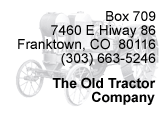


 |
 |
||||
 |
|||||
ManualsHow often has a collector hit a dead end when working on a project? Or broken a rare part attempting to remove it? Often, a manual can spell the difference between disaster and success. Today's knowledgeable collectors know that it is simply not enough to have a tractor and a toolbox. Knowledge is crucial and a technical library can be the key to a successful restoration. We can offer parts catalogs, operator's manuals, service manuals and even some sales literature for many tractors. Most are quality reprints although we will offer from time to time original vintage manuals, some over 70 years old! We are constantly adding to our inventory and have available here many manuals that are either rarely encountered or not available anywhere else.Listed below you will find the different manual types we have available. Click on a manual type to view some of our inventory OR scroll down to view a basic explanation of each type of manual offered and its potential benefits.
Operator's Manuals- An operator's manual is basically the book that was originally given to the new owner when a tractor or implement was sold. It usually listed the basic specifications of the tractor, such things as size, fluid capacities, horsepower, etc. It is valued today for the coverage of routine maintenance procedures that were commonly encountered by the operator. Such things as adjusting, servicing, and operating the unit are all covered here. A commonly overlooked benefit to today's restorer is that quite often many pictures were used to illustrate various points in the manual. These are quite helpful in providing a look at what the tractor would have originally looked like.
Parts Catalogs-A parts catalog is perhaps the most valuable manual that can be purchased. What it lacks in technical information is more than made up for by providing detailed information and views of the parts that were used to build a tractor. What part was used on which tractor, which part is correct for my tractor, what is missing from my tractor, and how does this all go together are all questions that can successfully be answered by studying a parts catalog. A collector should make purchasing a parts catalog his number one priority.
Service Manuals-A service manual details the exact procedures used to disassemble and assemble a tractor. Armed with a service manual, a restorer can often perform most required repairs by himself. Torque values, tolerance specifications, testing procedures and more are all found in a service manual. Countless hours of wasted effort and money can be saved by using a service manual. The majority of tractors have service manual available, and those that don't can often utilize one from a similar tractor.
Sales Literature-Many times the only way to answer detailed questions when restoring a tractor is to either look at an original example or study a sales catalog to see how a tractor was originally manufactured. A sales pamphlet is also helpful in determining what matched equipment was offered for a tractor and the different options that were offered when the tractor was new. Remember, it is best to use a reprint as a reference manual when restoring a project. No one wants greasy thumb prints on an original manual! As always, please contact us with any questions or concerns that you may have. |
|
|||||||||||||||||||||||||||||||||||
home | features | news/articles | item request form | contact us | links |
©Copyright 2005 The Old Tractor Company. All rights reserved.
|